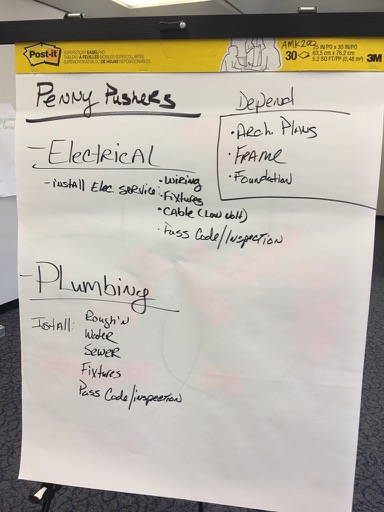Simulation Blues
After instructing “SAFe® for Teams” a half-dozen or so times now using the stock slides I decided to experiment with simulation improvements to address concerns / challenges students have had learning about program level PI Planning on a team of teams in SAFe context. The geekbooks.com simulation and intent and timing of SAFe for Teams as part of the overall “Implementation Roadmap” does not fit my client. Financial services and information technology go hand in hand. One size fits all courses…don’t. That being said, the content, slides/materials and learning path are top-notch quality from the amazing thought leaders at Scaled Agile. They have to please everybody. But the use case here with my client is different. Hence the experiment.
I have been teaching SAFe for Teams over the past few months with the stock v4.x slide deck and in musca change of the geekbooks simulation in favor of “Building a House.” It was quite a bit more effective as a learning tool than the stock simulation. However it takes much more time for setup of features and story development. Plus I had to coach the Exec/PMPO/Arch’s on the context vision slides separately. PO’s had to have time to write up the features while the other instructor continued with the course. Or as in most cases I teach by myself (not recommended)… we take a class break while the PO’s and I create features.

Since then I have found some time to create new slides to draw in the context of the Build a House PI planning simulation into the SAI instructional material (no I don’t change any of their slides; license compatible; Enterprise client).
The Lean-Agile Experiment
The first experiment with the build a house simulation formalized (private/enterprise) into the Scaled Agile “SAFe for Teams” course with my client wrapped up today. The improvement backlog is going to have quite a few items in it. 😁
But, I will say the students still did exceedingly well at understanding what needed to be done in SAFe PI Planning context and execution. They learned, fast. Look at the way they identified the domains necessary to delivery the product (picture; “a luxury home”). This self-organization concept doesn’t get much coverage in the stock simulation? With only one team of teams they mapped out domains to their self-organized teams. Cool eh?
Speaking of self-organization. The students in this 4/13-4/14 course were excellent self-organizers! There were only a few “SAFe” experienced students in the course so the end result was still impressive. I taught the slides, gave a few pointers, and let them at it without much coaching. Mostly just observation and note taking. Good job teams.

What needs to be improved
- I neglected to set the stage for the opener in the course slides largely because of the desire to give more context on the entire PI Planning ceremony in SAFe terms. I pulled in some slides from Leading SAFe. But not all the slides I needed. Rather than dealing with changing stock slides I’m going to create completely new ones to set the stage properly for the simulation.
- The opening vision briefs need to have a few context slides for Teams students. Without the context they don’t get the understanding of where they are in the simulation.
- Providing the “prioritized” simulation top 10 features just confused everyone. When I was running this ad hoc and having 2-3 student PO’s create the features themselves, they built ownership and understanding with it. The set that I handed them in slides and handouts along with the starter stories broke the simulation in part. I had to retro and fix during the course in lessons 3-5. Next time, I’m going to seed 3 of the top features and reduce the starter stories by 60%.
- When I added in the new slides, I broke the cadence of the learning path through the PI Planning simulation. I am going to have to reorder the slides to match the learning path / simulation and context of the PI Planning event.
- What did I miss?
What should I continue doing?
- I had learned in my first few iterations with the new simulation that you have to provide assumptions for the process to move forward effectively. Mostly, tell the students that the owners picked a design already, blueprints are complete. The contract is signed and all initial permits required to start are received by the general contractor. This keeps the students out of the weeds of the part of the process that many people don’t understand or have experience with. (for the record, I sort of…uh forgot to do this yesterday. Oops, sorry.)


“SAFe® 4.0 for Teams” is a registered trademark of Scaled Agile, Inc.


